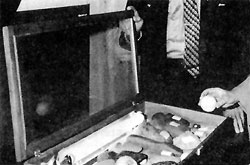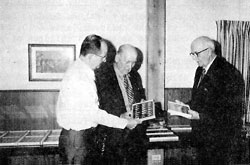A glimpse at 8,000 years of history
"He lives twice who can at once employ the present well and even enjoy the past..."
Some of the tools used by people inhabiting the land of the National Accelerator Laboratory over the past 8,000 years returned for a brief visit on Wednesday, November 22, Mr. August Mier of Batavia brought his unique collection of over 900 pre-historic artifacts to the Laboratory, picked up in over sixty years of walking the grounds which are now part of the world's largest facility for the study of subatomic particles.
As the prairie land was cleared for farming in the late 1800's, plows turned up many of the objects that had been hidden so long. Many people, like Mr. Mier, began to collect the strange souvenirs - pieces of bone and pottery, tools, and the arrowheads used for hunting by the ancient peoples. Many of the pieces are works of art, in stone, slate, and metal.
One of Mr. Mier's prized sets of arrowheads he calls Fox Valley Clipped Wings - small, precisely-shaped points with delicate serrated edges. "I don't think these were used for hunting," he says. "They are too fragile. They were either used in ceremonies or to demonstrate the skill of the maker. They are very rare."
Mr. Mier mounted his collection on bright-colored foam material inside stainless steel frames 9 inches x 12 inches. He arranged the points in a variety of designs, grouped according to the location where he found them. Each piece is labelled with the date of finding which coordinates with a master log book Mr. Mier maintains. He walked most of the twenty-five mile area around Batavia, an exercise he began after an injury he suffered in World War I threatened to disable him.
In 1971 Mr. Mier loaned a portion of his collection to Miss Ann Early, an archaeologist who spent two summers studying the NAL site. His careful recording of the locations of his findings allowed Miss Early to identify thirteen additional sites where life had previously existed. Miss Early found that Mier's collection included samples of seven cultural traditions dating back to 7,000 B.C. Mr. Mier's collection was carefully photographed for inclusion in NAL's historical records.
The relics represent not only glimpses into the life styles of those people who roamed so long ago, but also Mr. Mier's recollections of the past sixty years and the people who settled the prairies of the NAL site. As a youngster wandering the fields, he listened to tales that were told of wood cutters in the NAL "Big Woods" levelling by hand walnut trees four feet in diameter that were then shipped from Chicago by boat to England. Another group of men told of an oak tree on the Griffith property eight feet in diameter that took two weeks to cut down.
"It was a time when there were flocks of quail and prairie chickens here. The swamps had geese, ducks, plover and snipe. Some had fish, and I have seen many strings of yellow-bellied bullheads caught there. Turtles were a nuisance, and some days logs were loaded with them, sunning themselves," Mr. Mier recalled.




